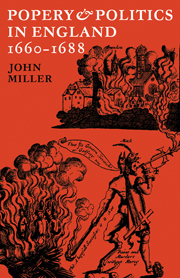Book contents
- Frontmatter
- Contents
- Preface
- Abbreviations
- Note on spellings and dates
- Introduction
- 1 The Catholic laity
- 2 England and Rome: the Catholic clergy
- 3 The penal laws and their enforcement
- 4 The development of the anti-Catholic tradition
- 5 The Restoration settlement and after
- 6 The French alliance and ‘Catholicity’
- 7 York and Danby
- 8 The Popish Plot and the Exclusion Crisis
- 9 The Tory reaction
- 10 James II and the Church of England Men
- 11 James II and the Dissenters
- 12 James II and Rome
- 13 The missionary effort under James II
- 14 The opposition to James II
- Appendices
- Select Bibliography
- Index
8 - The Popish Plot and the Exclusion Crisis
Published online by Cambridge University Press: 07 October 2011
- Frontmatter
- Contents
- Preface
- Abbreviations
- Note on spellings and dates
- Introduction
- 1 The Catholic laity
- 2 England and Rome: the Catholic clergy
- 3 The penal laws and their enforcement
- 4 The development of the anti-Catholic tradition
- 5 The Restoration settlement and after
- 6 The French alliance and ‘Catholicity’
- 7 York and Danby
- 8 The Popish Plot and the Exclusion Crisis
- 9 The Tory reaction
- 10 James II and the Church of England Men
- 11 James II and the Dissenters
- 12 James II and Rome
- 13 The missionary effort under James II
- 14 The opposition to James II
- Appendices
- Select Bibliography
- Index
Summary
The Popish Plot, breaking on an already tense situation, finally brought into the open the issues raised by James's conversion. After the fall of Danby and the disbanding of the army, James's exclusion from the succession to the throne became the dominant political issue. The Plot tended to die a natural death and was resuscitated with increasing difficulty as time went on. The great wave of popular fear of 1678–9 had long since subsided when the crucial confrontation over the exclusion bill took place in November 1680. There was no violence after the Lords had rejected the bill. The spontaneous and immediate fear of Popery, from which the project had grown, had now cooled. It was terrifying to imagine that the Papists might cut one's throat tonight, but much less so to consider the possibility of this happening at some indeterminate time in the future.
The Whigs' tactics were basically very simple. They played on the fears of Popery and represented James's exclusion from the throne as the only sure safeguard against it. The king's tactics were more complex. First, he enforced the penal laws and investigated the plot in the hope of allaying the popular fears. Secondly, he refused to accept his brother's exclusion and instead offered various limitations on a Catholic successor which both the king and the Whigs believed would prove ineffectual. Thirdly, Charles fought a skilful delaying action in order to prevent a trial of strength over the exclusion bill until he was sure that he would win it.
- Type
- Chapter
- Information
- Popery and Politics in England 1660–1688 , pp. 154 - 188Publisher: Cambridge University PressPrint publication year: 1973



